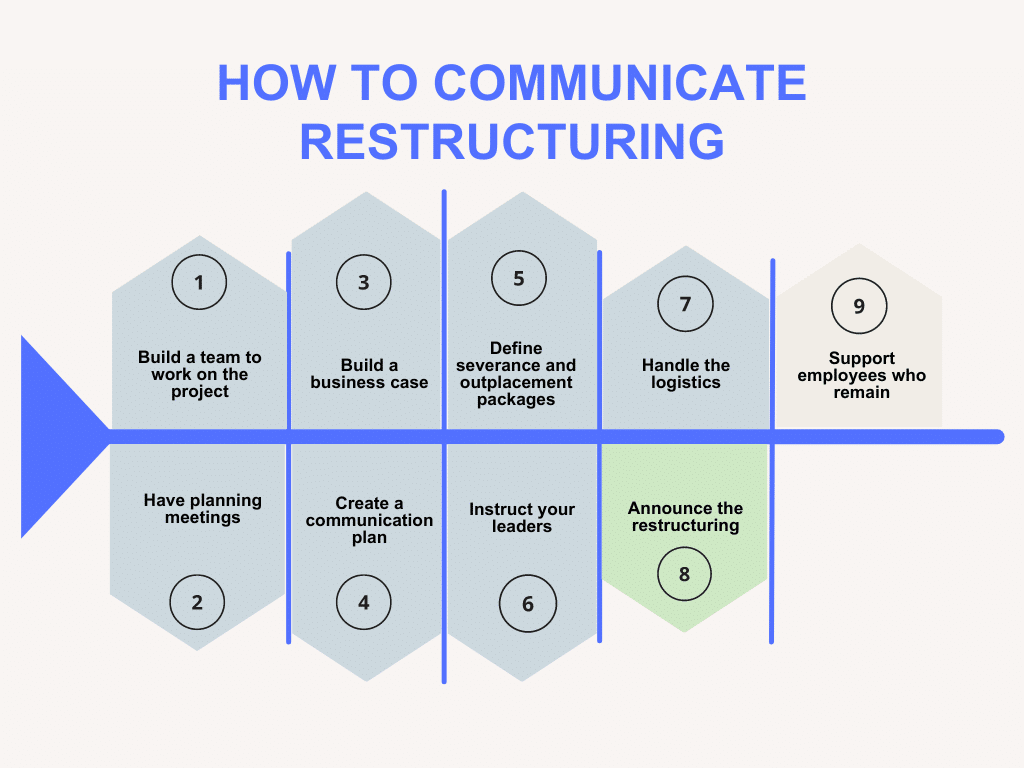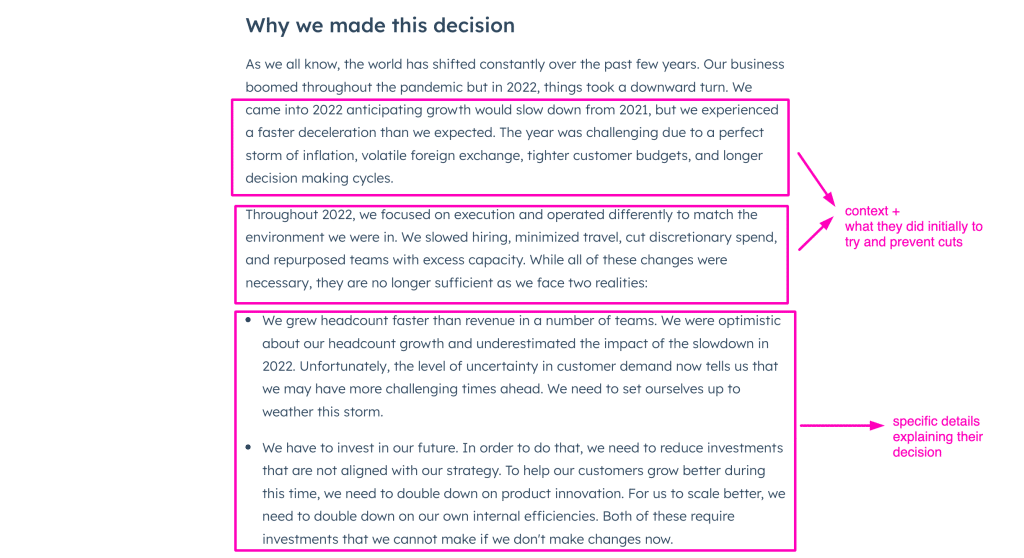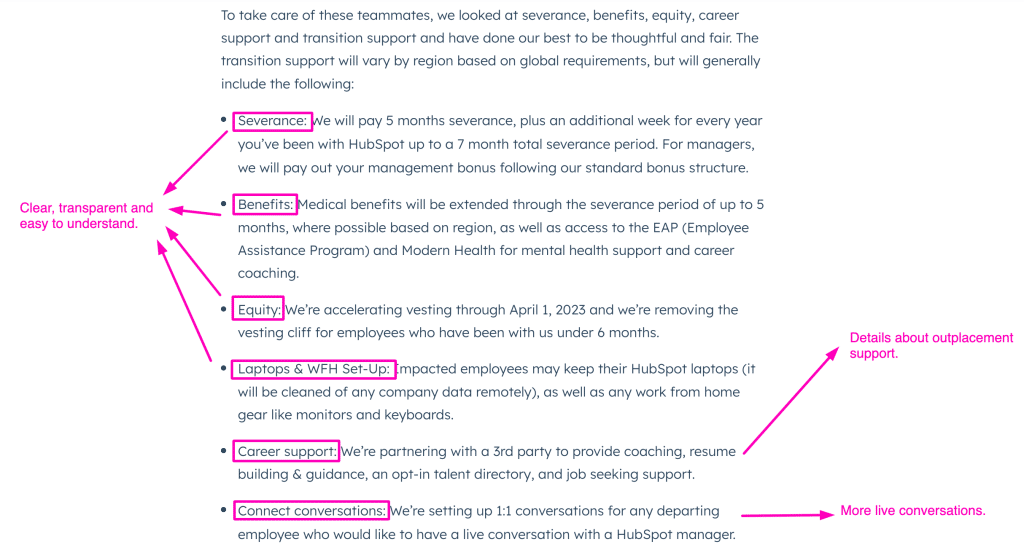A year ago, a friend of mine packed his life and moved across the continent to work for a company he’d been raving about for years. It was a dream come true — a snazzy Amsterdam office, immaculate onboarding, a great team, and megabucks.
Last week he learned he was being laid off, together with the team he was managing.
When I asked him how he was doing, he said: “I actually think we’re all gonna be alright”.
I was really thrown off by this.
Layoffs are nasty. They show if companies really stick to their values, expose bad internal communication and lack of processes, and reveal how graceful the company management is in critical moments.
But I knew that, if done right, layoffs can let you prove your value as an employer. So I probed further.
It turned out that his company had developed a rock-solid restructuring plan and outplacement options.
Now I was intrigued. How did they communicate layoffs? What kind of support did they offer? What can we all learn from their example?
Today, I’ll go over all the details in this article.
Here’s what you’ll learn:
- Why restructuring communication is vital for staff,
- How to organize the announcement process, and
- A template + examples you can use when you need to announce restructuring
What Is Company Restructuring?
In business, restructuring is when a company goes through significant organizational and operational changes in order to remain competitive, reduce costs, or overcome a financial crisis.
Restructuring can involve merging, reorganizing departments or changing the management structure, but in most cases, it also involves downsizing and layoffs.
One would expect employees to be dismissed for misconduct, poor performance or breaking company rules. But in the company restructuring scenario, you often have to let some of your best people go, or eliminate entire departments, simply because there is no longer a need for those roles.
These circumstances will require you to pay extra attention.
How You Communicate Restructuring Will Make or Break Your Employer Brand
Whenever a transition happens, especially a delicate one that involves cutting your workforce, there’s a single (yet very complex) thing you absolutely must do right — communicate the change.
Once you announce restructuring, confusion and anxiety may sweep the workforce. Sometimes, employees aren’t even sure what exactly is happening and what kind of changes they should expect. Am I being moved to another department? Should I expect a pay cut? Are they removing my benefits? Am I being let go?
So it’s on you as the employer to come up with a restructuring communication plan and define the process, where you’ll lay out things like:
- Who will inform which employees, when and how
- Which channels of communication to use for the announcement (e.g. face-to-face, email)
- What your messaging is going to be and how to keep it consistent and supportive
- What options you’ll give the employees to provide feedback and ask questions
- How you’re going to support those who are being laid off (e.g. severance packages, outplacement services, vesting…)
If you approach restructuring strategically, you’ll avoid (or at least minimize) the possible negative outcomes like:
- Impacted employees leaving negative comments on social media
- A ripple effect of negative reviews on employer review websites like Glassdoor
- Wrongful termination claims and lawsuits
- A direct hit on the remaining employees’ morale and productivity
| Keep in mind: The National Labor Relations Board recently ruled that employers can no longer demand that laid-off employees keep quiet about the terms of their exit packages and forbid them to publicly post disparaging comments about the company as part of their severance agreements. |
The key takeaway is that layoffs are something you really need to think through.
Remember, this is a massive change that affects everything and everybody — the now-former employees, those who stay, your employer brand, your standing, and your ability to attract talent in the future.
How to Communicate Restructuring
For company restructuring to go smoothly, here are some steps you can take:
- Establish a team to work on the restructuring project
- Organize a planning meeting to go over the details
- Build a business case
- Create a detailed communication plan
- Decide on the severance packages and outplacement services
- Instruct your leaders and keep the messaging consistent
- Handle the logistics
- Announce the restructuring and layoffs
- Support the employees who remain too

Before we analyze these steps, back to my buddy and his company for a second.
As they announced the restructuring, I started seeing dozens of #laidoff confessions on LinkedIn, but zero vitriol or shaming. Most of the people were sad, but thankful for the time spent at the company and how the layoffs were handled.
The company was doing it right, after all.
If your company is currently getting ready for restructuring and you’re unsure how to lay off employees with clarity, care, and compassion, read on. We used his, as well as some other good (and not-so-good) examples to give you a step-by-step guide on how to communicate a layoff.
| Before you begin: You don’t have to be an enterprise laying off thousands of employees for this to matter. Even if you’re a startup and only a handful of employees are being let go, the tips below will still make sense. |
So here’s how you can organize activities before, during and after layoffs.
1. Establish a team to work on the restructuring project
Step one – create a cross-departmental team to plan and organize the restructuring process and organize layoffs. This task force usually includes direct managers and appropriate HR personnel. If needed, you can engage an outplacement firm and have their representatives handle parts of the process.
2. Organize a planning meeting to cover the details
Once you know who’s going to participate in the project and what each person’s role would be, get them all in a room (or a Zoom session) to go over the details and strategize the restructuring.
Remember, this will still be a top-secret project at this stage, so make sure to treat it as such.
When booking calls or the conference room, don’t name the meeting “Emergency Executive Call” or “Restructuring Plan” cause you’ll raise more than a few alarms. Instead, give it an ordinary, inconspicuous name you’d give to any other meeting.
If your meeting rooms aren’t soundproof, organize the event outside the regular working hours. Or even better, take it offsite or switch to Zoom.
3. Build a business case
Be ready to explain why you made this decision, and use that information in all your communications. Saying you’re downsizing because of the “market conditions” or “recession and geopolitical climate” is generic and insensitive.
To really make a difference as a business leader, give the impacted employees as much honesty and transparency as possible. Make sure people understand why you’re doing this, what you did to try to prevent it, and how you’ll support the employees who are leaving.
Take this stellar example by Hubspot, whose CEO Yamini Rangan said in a message:

Why this works:
In this email (which soon became publicly available on the company website), the CEO provided a lot of background information to explain why the 7% cuts in workforce were necessary. Hubspot was one of the many tech companies which experienced a surge in customer demand at the beginning of the pandemic. They quote inflation, volatile foreign exchange, tighter customer budgets, longer decision making cycles and the end of WFH as the reasons that affected their decision. They also cite specific actions that were done in an attempt to prevent layoffs (minimized travel, cut discretionary spend, repurposed teams and slowed hiring). By doing this, they really supported their decision with data and offered a clear explanation why downsizing was inevitable for the success of your business.
Another recent example is Atlassian, whose co-founders
4. Create a detailed communication plan
The next step is to create a timeline of when and how you’re going to communicate your decision to various stakeholders. This involves things like:
- Informing the board
- Informing department leaders
- Planning out how you’ll communicate internally and externally (timeline and channels)
- Defining your messaging and try to connect it with your mission and employer core values
- Creating a backup plan in case something goes wrong (e.g. information is leaked)
5. Provide outplacement services
This is also the time to think about the severance packages and outplacement support you’ll provide to those who are being let go.
Some things to consider here are the separation package length, unused PTO, extending healthcare benefits, visa support, what happens to WFH equipment (if any) and the details of outplacement services programs (e.g. job interview coaching, resume-building and other job-seeking guidance).
6. Instruct your leaders and keep the messaging consistent
Once the department leaders are briefed, they will need to be supported with how to deliver the message.
This is a key stage in the process because everyone needs to be 100% clear on what to say and how much’s at stake if the message is communicated poorly.
Remind your leadership team about the consequences of poorly handled layoffs – ruined relationships with great employees, negative job board reviews, laid-off folks badmouthing you on social media, or damaged employer brand.
To equip your leaders and keep a united front, create and provide materials and documentation in advance, standardize the process and organize training sessions. This way, your managers will be more confident when delivering the bad news.
Coach your leaders to:
- Deliver the message with empathy and respect, yet remain efficient and clear
- Handle emotional reactions and possible outbursts
- Answer all the questions (Your HR can provide role-play exercises and an FAQ document to help them prepare)
- Control their own emotions (dismissing a good employee is hard for managers too)
- Follow the script (or bullet points) when speaking. Instruct them to avoid improvising because you want to have a unified message across all departments.
- Communicate the news to the employees who are staying and work with them to ease the transition.
7. Handle the logistics
Depending on the number of jobs being eliminated, you’ll need to think through the entire D-day. What practical steps do you need to take so that everything goes as smoothly as possible?
- Brief your IT team and provide them with the timeline and list of people whose access will need to be cut off.
- Finalize severance and outplacement packages.
- Monitor social media for conversations about your company and assemble a team to respond in line with your messaging strategy.
- Prepare a public statement (if you decide to do it)
- Get extra HR and security staff (in case somebody needs to be escorted off premises)
- Consider timing. It’s best to notify everyone impacted within a short time frame.
8. Announce the restructuring and layoffs
When the day comes, you’ll have to think on two levels – 1) how to handle individual announcements; and 2) how to map out the organization-wide communication.
How to handle 1:1 conversations
- Notify each impacted employee individually (if feasible). On the day of restructuring, book a 30-minute meeting with each employee and choose a private space. If you’re doing it virtually, make sure your camera is on. And if you need to do it by email, prepare your drafts in advance, personalize them, and send them out at the same time.
- Focus on “jobs” and “roles” being eliminated, not employees. Provide a brief explanation of the layoff and stick to the script. Remember to thank the employee for their contribution and reassure them that they shouldn’t take this personally and that the decision was not performance-based.
- Be quick (but show empathy). This day won’t be easy and you might get nervous and uncomfortable. Still, do your best to avoid meandering and chit-chat (that’s why it’s best to practice in advance). Make sure to deliver the message in the first few minutes of the meeting. You can prepare the employee by starting with “I have some bad news today”.
-
- Speak clearly. You want to be direct and leave no room for misinterpretation. Ensure that the employee understands that the decision is permanent and what happens next.
- Have another person in the room. For legal reasons, and for your comfort, it may be a smart move to have another person with you as you deliver the news. It can be someone from the HR department or an outplacement services representative.
- Explain the details of the severance and outplacement packages. This is big. You want to anticipate the questions and concerns they’ll have. Make sure to provide answers to questions like when their last day is, what happens to their benefits and how you’re going to support them while they plan for their next step.
- Give them the opportunity to ask questions. Even if you organize an All Hands meeting later to fill everyone in, leave some room for questions at the 1:1 too.
- Send a follow-up email laying out the details. Upon hearing the news, your people can be overwhelmed and confused, and they could easily forget the details. That’s why it’s important to repeat them in written form (a great way to avoid answering the same questions).
If you’re unsure how to stay on point, you can use this restructuring communication template:
| For business reasons like [REASON] and [ANOTHER REASON], we’ve had to make some changes that affect your job. I’m sorry to inform you that, despite everything we’ve done to prevent it, we’re now in the position of having to lay off our [EXAMPLE] department and your position is being eliminated. [DATE] will be your last day at the company. As for the next steps, you’ll receive [MONTHS] of severance pay. We’ll also pay for your unused vacation, and provide a career development plan to help you with the transition. Your access to email, Slack and [RELEVANT OTHER TOOLS] will be rescinded immediately, but we have your personal email address and phone number, and we’ll be in touch there. |
You can find more examples and a full exercise here: Better Approach to Outplacement & Employee Transition.
What next?
How to handle the company and public announcements
A good practice is to organize an All-Hands meeting to share the news with the entire company and release a public announcement on your website.
Make sure to reinforce your business case and stick to the messaging you defined in the initial stages of restructuring.
Looking back at the Hubspot example, here’s how they communicated their decision with transparency, compassion and clarity:

Hubspot did a great job announcing their layoffs and supporting their entire team with a solid restructuring process. Here’s the link to the full message from the HubSpot CEO.
9. Support those who remain too
You’d typically think the employees who haven’t been impacted by restructuring would be happy to have dodged the bullet. Think again.
Survivor guilt is real – Some of them have lost team members they cared for and enjoyed working with. After the restructuring, their roles and day-to-day responsibilities may have changed. Maybe they needed to take on some extra work that had previously been done by someone who was let go.
For them to stay focused and productive, and nurture the employer brand after the cuts, they too need support in form fo regular check-ins and training. Encourage them to ask questions and raise concerns honestly. If no more cuts are planned, reassure them that their roles are safe.
Final Thoughts
There you go. Now you know everything about the best practices for communicating restructuring to employees. And you can always come back to this checklist if you need extra help.
As you organize the restructuring process, here are some other resources you may find useful:
- Learn how to strategize internal promotion
- Learn about the different outplacement services and how to pick the best option
